We all know that house flies are annoying, especially if it seems like a swarm of them have moved into your home permanently. So, if you have a house fly problem in your home, what can you do to get rid of them and prevent them from invading your home?
How to get rid of house flies? To get rid of house flies, cover garbage containers, keep your area clean, repair broken window screens or doors, use traps, or use fly repellents. To get rid of them naturally, buy a carnivorous plant, plant herbs that can repel them, such as basil and lavender, and make a spray with a mixture of vinegar and dish soap.
So, let’s talk more about house flies and how you can get rid of them for good. We’ll be discussing the life cycle of house flies, and what they eat so you can starve them out. We’ll also go over some of the best ways to trap, repel, and kill house flies so that you’ll be able to live fly-free.
All About House Flies
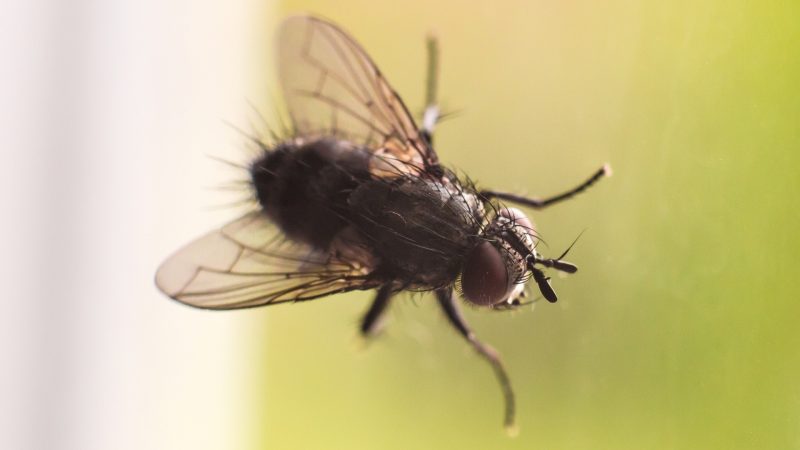
If you want to get rid of your house flies, it’s essential to understand what kind of house flies you have to figure out where they’re getting food and breeding.
Types of House Flies
House flies may seem like a common pest in your home, but have you ever noticed that there are many different kinds of flies that like to live indoors? The most common types of house flies include:
- House Fly: When you think of flies that live around humans, the common house fly, or Musca domestica, is the first species that comes to mind. They’re grey and have broad, dark stripes on their wings and thorax. They frequently live anywhere they can find human or animal waste, such as in garbage, near livestock, or around compost heaps.
- Blow Fly: Blow flies are among the most common types of flies that live indoors. They have metallic, shiny black or blue bodies and transparent wings. They’re scavengers, and they primarily eat human and pet waste.
- Fungus gnat: Fungus gnats feed on fungus in the soil of gardens or houseplants, so if you see dozens of tiny flies around your plants, they’re probably fungus gnats. These gnats can be beneficial in small numbers since they’ll remove fungus from your plant’s soil.
- Fruit flies or vinegar flies: Fruit flies, also known as vinegar flies, are also prevalent house flies. They’re some of the smallest flies, making them challenging to get rid of. They feed on yeast produced by overripe fruit, compost, beer containers, vinegar, and wine bottles. They move inside during the late summer and fall.
Where Do House Flies Come From?
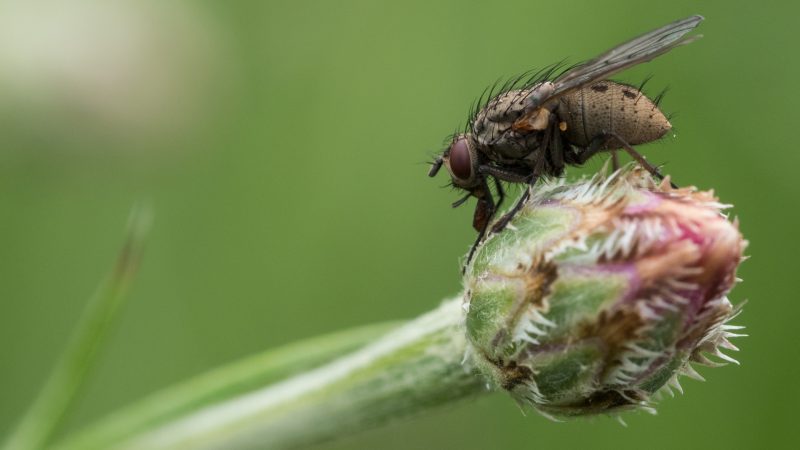
Some house flies breed outside and then get trapped inside when you leave a door or window open. While most only end up inside accidentally, sometimes they’ll look for a warmer indoor location when the weather gets colder. Most flies are dormant or hibernate during the colder months, so many of them will look for a warm place to rest for the winter.
Small flies such as fruit flies and fungus flies can breed indoors if they have a food supply. Fruit flies will feed on traces of sugar left on your counters, ripe fruit, compost, garbage, and unwashed alcoholic beverage containers. Fungus flies breed in soil, especially if the dirt is soaked, which often makes them prone to colonizing your potted plants.
How Long Does House Flies Live?
House flies generally complete their life cycle within 15 and 25 days, but they can live for up to two months in some cases. During the winter, they lie dormant deep under manure piles, compost heaps, or garbage in their larval stage. In the spring and summer, they can go through up to 20 generations.
Fly eggs hatch 8 to 12 hours after they’re laid, and it takes up to two months for the larva to become a pupa and, finally, turn into a fly. Without food, these flies can only survive about two days, but they live for at least one month if they always have plenty of sugar.
Related: How to Get Rid of Flies Outdoors – Proven Techniques!
What Do House Flies Eat?
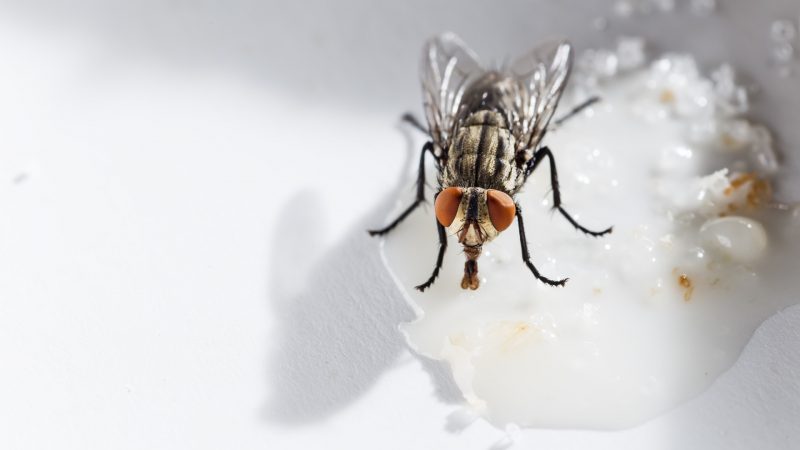
House flies go anywhere that they can find food. Each type of house fly likes a different kind of food, so determining the type that’s in your home can help you determine how to get rid of them.
Common house flies can eat almost anything that contains sugar. Blow flies eat animal waste or decompose animals. Fruit flies and vinegar flies eat the yeast present in bread, beer, wine, vinegar, pickled foods, and dairy products. Fungus flies only eat mushrooms and other fungi that grow in the soil.
While some houseflies like fungus and some like yeast, over-ripened fruit, or meat, others can eat almost anything. That makes your garbage can the prime spot for fly reproduction, as it contains everything that a fly needs to survive.
Where Does House Fly Lay Eggs?
House flies lay their eggs that look like tiny rice grains underneath the soil, manure, compost, or other garbage. Usually, flies like to bury their eggs in a food source so that they’re not disturbed or eaten by other insects before they hatch. One female usually lays up to 500 eggs at a time, and they hatch mere hours after being laid.
Related: How to Get Rid of Horse Flies | Long-Term Results!
Are House Flies Dangerous?
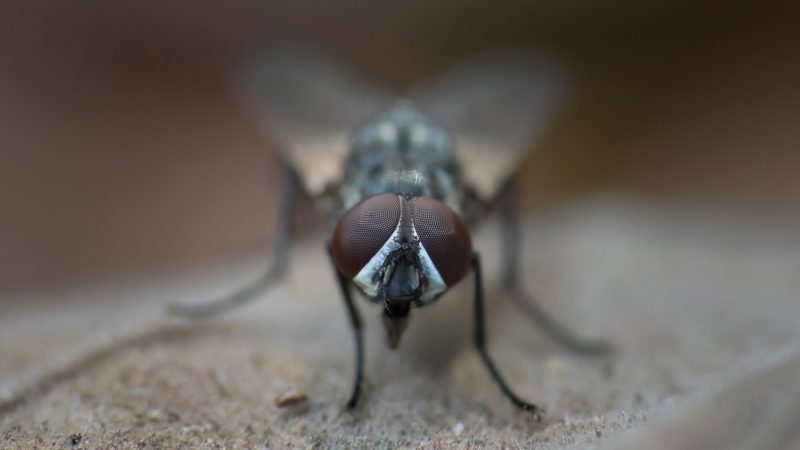
Most house flies are harmless, although blow flies and house flies do pose a health risk. Blow flies eat by chewing solid food, spitting it out, and drinking the sugars from their pre-chewed food. Since they chew and spit wherever they go, they can spread harmful bacteria that can cause gastrointestinal infections and viruses.
House flies can also contaminate food if they land on it since their feet have tiny hairs on them that carry traces of whatever else they have landed on. These hairs can carry fecal matter, bacteria, fungus, viruses, and other contaminants, so it’s best not to eat anything that flies have landed on.
Do House Flies Bite?
Generally, house flies don’t bite. To eat, flies have to suck up their food in liquid form, so they cannot bite people. The only types of flies that do bite are stable flies, deer flies, horse flies, black flies, sand flies, biting midges, and mosquitoes, all of which have a long proboscis that they use to suck and consume blood.
How Houseflies Can Harm Humans?
Houseflies may not sting or bite as painfully as bees and wasps, making them appear harmless. Flies can easily take up bacteria that can contaminate your food since they frequently live and feed between trash and decomposing stuff.
When a fly feeds on food or on surfaces that people touch, transmission frequently happens. There are several diseases that these flies might bring on, including:
- Food poisoning
- Dysentery
- Cholera
- E. coli
- Typhoid fever
- Tuberculosis
- Eye infections
What Attracts House Flies?
House flies are attracted to decomposing food and human waste. Each type of fly is attracted to a specific kind of food. House flies eat meat, fruit, vegetables, and waste. Fruit flies only eat yeast from fermented sugars, and blowflies prefer meat.
Related: How to Get Rid of Blow Flies | No-Nonsense Guide
Why Are There So Many Flies in My House?
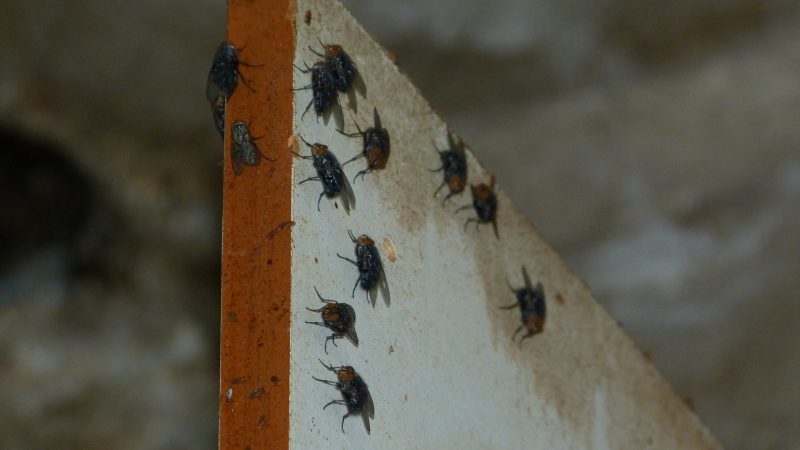
If you have a fly problem in your home, it’s only natural to wonder what house flies are attracted to.
Most of the time, flies will only enter a house by accident. If your home is clean and there’s little food left out for them to eat, the probable cause of your fly problem is a broken window screen or an open door. Once they get stuck inside, they may have trouble finding a way back outside. Repairing any broken window screens and keeping your door closed will fix the problem if this is the case.
Still, some types of flies can breed inside your house, and they’ll stay and breed if they have a food source. Leaving out food such as fruit, dirty dishes, and unwashed alcoholic beverage containers can attract flies. Additionally, all of the most common types of house flies can breed in a garbage container or indoor compost bin.
What Attracts House Flies Outside?
Garbage, compost, and empty alcoholic beverage containers are the main attractor of house flies. However, other things such as animal waste, fungus, and decomposing animals can also attract flies.
How To Get Rid of House Flies Infestation? | Step-by-Step Instructions
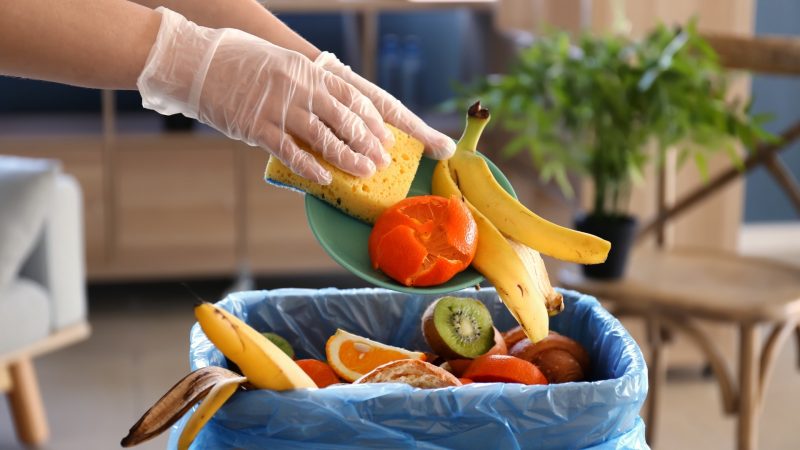
1. Clean. Cleaning is always the first step to getting rid of flies. Take out your garbage, vacuum, clean surfaces, put all food away, and ensure that there’s no food residue left for flies to snack on.
2. Seal all food containers. Flies will only infest your home if they have a food source, so ensuring that all your food is stored in airtight containers or in a fridge will keep the flies from reproducing.
3. Set traps. You can use almost any kind of trap, such as flypaper, a bug zapper, or homemade fly traps to kill off the flies that are infesting your home.
4. Close and seal windows and doors. To keep more flies from coming in, you may need to repair doors or window screens with holes large enough for flies to enter through.
Getting Rid of House Flies in Some Specific Places
Depending on whether your house flies are outside, in an apartment, in a house, or at a restaurant, you may want to take different steps to repel and kill them.
How To Get Rid of House Flies Outside?

If you’ve noticed a fly infestation outside, it may seem impossible to get all of them away. Still, there are some steps you can take to keep flies from breeding in your outdoor area and repel them.
1. Cover your garbage. If you have a garbage can or dumpster outside, always ensure that the lid is securely fastened. Keeping it contained will keep flies from laying their eggs in your trash.
2. Cover your compost. If you have a compost pile, you probably have flies. To keep flies from chowing down on your compost, keep them in a bin with a tightly fitting lid.
3. Plant fly-repellent plants. Fragrant herbs such as lavender, basil, mint, and catnip are excellent natural repellents for flies. Plant them near your doors or garbage containers to keep flies away.
4. Set up fly traps. Using outdoor fly traps or liquid fly repellants can keep flies from breeding in your outdoor area and kill many of them.
How To Get Rid of House Flies in an Apartment?
If you live in an apartment, flies can easily be attracted by your neighbors, making it more challenging to get rid of them for good. Still, there are several things you can do to make your apartment as inhospitable to flies as possible.
1. Clear your apartment of garbage. Remove all trash from your apartment and take it out to a dumpster or outdoor garbage can.
2. Deep clean. Since flies chow down on sugar, fungus, and food debris, scrubbing your counters, floors, tables, and bathrooms will eliminate any potential food sources and kill off your house flies.
3. Cover your garbage can. To keep flies from making a nest in your garbage, keep it covered at all times with a lid.
4. Store all of your food. While keeping a fruit bowl out can be attractive, flies will quickly take over any food left out. Store your food in a refrigerator or in cabinets at all times to get rid of your flies.
5. Keep the door and windows closed. To screen out the flies, keep your windows and doors closed as much as possible. If you want to keep your windows open, you may want to ensure that there are no holes that fly can get in through and have your landlord patch them up.
How To Get Rid of House Flies at Home?
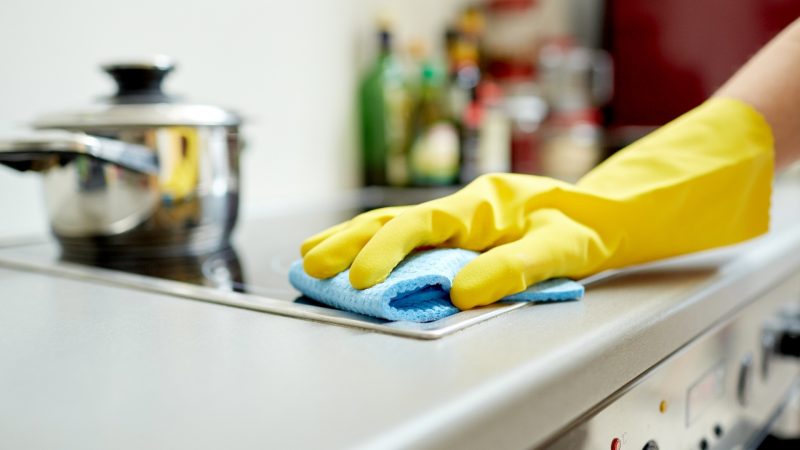
If you have a fly infestation in your home, you may want to:
1. Take the garbage out. To start, collect all the trash from your home and take it to your outdoor garbage container.
2. Get rid of empty alcoholic beverage containers. Since fruit flies are attracted to yeast, rinse and get rid of all beer bottles, wine bottles, and vinegar bottles. Ensure that all of your alcohol and vinegar containers are closed.
3. Clean your kitchen. Since flies are attracted to sugar and food waste, clean your kitchen and dining area thoroughly with an antibacterial cleaner.
4. Put all of your food away. If you have any fruit or other food sitting on your counter, secure it in your refrigerator or a cabinet. Always put food away after you’re done with it.
5. Keep the windows closed. If you think that flies might be coming in through your windows, keep them closed or ensure that there are no holes or gaps in the screens.
How To Get Rid of House Flies in Restaurants?
Flies love restaurants because there’s always food around for them to eat, and the doors open and close often enough that flies can get in. Still, it’s crucial to keep restaurants free of flies. So, what can you do?
1. Keep the front and back doors closed. While keeping the door open can bring in some appreciated fresh air, leaving it open will attract flies. It’s best to keep the door closed as much as possible to keep flies from coming to dine in your kitchen.
2. Deep clean the kitchen. Cleaning all of the dishes thoroughly, disinfecting and clearing sinks, and keeping the kitchen spotless is the key to getting rid of flies.
3. Take the trash out and keep garbage cans covered. If you work in a restaurant, taking the garbage out daily is essential for keeping flies away. During the day, keep the garbage cans covered to ensure that no flies lay eggs in them.
4. Keep food covered. Keeping all of the food in the back covered will starve out the flies in your restaurant, so you should always put food back in the fridge or keep it protected throughout the day.
5. Set fly traps by the back door or dumpster. While it might not be a good idea to keep fly traps by the front door for all of your customers to see, keeping them in the back of the kitchen is an easy way to keep flies from coming into the restaurant.
What Keeps House Flies Away? | The Best Products To Get Rid of House Flies
Best House Fly Repellents
If you want a fly repellent that works against all types of flies, we’ve compiled a list of the top fly repellents so that you can get rid of your house flies for good.
- CAPTURES HOUSE FLIES & FRUIT FLIES: This innovative trap attracts...
- 24/7 CONTINUOUS ACTION: Dramatically decreases the number of...
- DISCREET & COMPACT: This trap seamlessly blends in with home...
- FAST ACTING: This flying insect trap starts working immediately...
- READY TO USE: With the hassle-free trap, there’s no mess and no...
- Effectively eliminate most flying insects: mosquito, Aedes,...
- EPA registered: The bulb light attracts flying insects, and the...
- Light weight & Easy to use: It’s very light so you can hang it...
- Easy to clean & Replaceable bulb: Dead bugs will fall onto the...
- Our bug zapper area coverage up to 1/2 Acre. Good for home,...
- Catch Flying Insects 24/7 - This flying insect trap uses blue and...
- Mess-Free Disposal - This indoor fly trap and gnat catcher uses a...
- Easy-to-Use - To use, remove the sheet from its adhesive backing,...
- Versatile Placement - You can place this plug in bug trap in your...
- Includes 1 Plug-In Device and 1 Cartridge - This plug in fly trap...
This fan uses reflective blades that scare off flies and other bugs all in one. With fantastic reviews, you can’t go wrong with this simple, chemical-free bug-repellent.
Best Indoor House Fly Traps
If you want to set a fly trap in your home, you can’t go wrong with one of these highly-rated traps.
- Catch Flying Insects 24/7 - This flying insect trap uses blue and...
- Mess-Free Disposal - This indoor fly trap and gnat catcher uses a...
- Easy-to-Use - To use, remove the sheet from its adhesive backing,...
- Versatile Placement - You can place this plug in bug trap in your...
- Includes 1 Plug-In Device and 1 Cartridge - This plug in fly trap...
- FAST-ACTING ELIMINATION: Notice a dramatic decrease in fruit...
- LONG-LASTING PROTECTION: Each ready-to-use, non-staining TERRO...
- DISCREET AND ATTRACTIVE DESIGN: The apple-shaped anti fruit fly...
- EASY MONITORING: This fruit fly catcher features built-in windows...
- TARGET BREEDING AREAS: These indoor fruit fly traps are most...
- IMMEDIATE INSECT CONTROL: The plug in fly trap indoor starts...
- CHILD AND PET SAFE: This indoor fly trap for home does not...
- CONTINUOUS 24/7 PROTECTION: This insect traps indoor option...
- DISCREET AND ADAPTABLE DESIGN: With its flying insect trap indoor...
- LARGE COVERAGE AREA: Offering protection over 800 sq ft
Best House Fly Killer Sprays
There are tons of fly-killing sprays out there that don’t work. That’s why we’ve put together a list of the best indoor fly sprays that kill insects on contact but won’t harm you, your pets, or your family in the process.
- Use on Flies, Gnats, Mosquitos and More - Zevo Flying Insect...
- Fast Acting Formula - This solution is the perfect bug spray for...
- Powered by Essential Oils - Zevo insect repellent uses bug-deadly...
- For Indoor and Outdoor Spaces - Use Zevo as an indoor insect...
- Shop Every Formula - Our Multi-Insect Spray, Flying Insect Spray,...
- Kills Common Household Pests Fast: Natural insect spray that...
- Plant-Based and Pet-Safe Bug Spray: Eco-friendly pest control...
- Dual Action – Kills Insects and Eggs: This natural pest spray...
- Long-Lasting Indoor & Outdoor Protection: Provides residual...
- Ready-to-Use and Eco-Friendly Design: Convenient 16 oz spray...
- Raid House & Garden Bug Spray kills bugs on contact and won't...
- Kills: aphids, boxelder bugs, caterpillars, climbing cutworms,...
- Insect spray with no lingering chemical odor
- This easy-to-use bug killer can be used indoors or outdoors....
- Repeat application of insect killer as often as necessary for...
How To Get Rid of House Flies Naturally?
If you have house flies, you may not want to use chemicals or traps to eliminate them. There are plenty of natural ways that you can use to trap, repel, and kill house flies using the things that you already have at home. So, here are some of the best home remedies to get rid of your house flies naturally:
- Carnivorous plants: Buying a carnivorous plant like a pitcher plant or Venus fly trap can help you eliminate the flies in your home.
- Flowers and herbs: Planting herbs like basil, lavender, catnip, and marigolds can repel flies.
Best Home Remedies for House Flies

Some other great, natural ways to repel and kill flies include:
- Essential oils to get rid of house flies: You can use vetiver, cinnamon, lavender, and similar essential oils to repel and kill house flies.
- Cayenne pepper spray: Mix cayenne pepper and water in a spray bottle, and use it to repel or kill flies in your home.
- Vinegar and dish soap spray: Mix some dish soap with vinegar and water to make a fly-killing spray that’s safe for pets and kids.
How To Catch House Flies?
If you want to catch all of the flies in your house, you can buy a trap or make your own at home with vinegar and a bit of dish soap.
Homemade Fly Trap
All you need is vinegar, some plastic wrap, a rubber band, dish soap, and a container like a cup or a jar to catch flies. To make your trap:
1. Mix vinegar and dish soap. Fill your container with about an inch of vinegar and add a few drops of dish soap.
2. Cover the container. Using a piece of plastic wrap, cover the container and secure it with a rubber band.
3. Poke holes. Use a pencil, scissors, or a knife to poke several fly-sized holes in the top of the plastic wrap.
4. Set the trap. Put your new trap by a window, near your garbage can, or wherever you notice the most flies in your home.
When the flies smell the vinegar, they will go into the trap and the liquid at the bottom. The dish soap will trap them and weigh down their wings, making them unable to fly.
List of Sources
Cranshaw, W.S., Peairs, F. B. (2017). Flies in the Home. Colorado State University Extension.
Sanchez-Arroyo, H., Capinera, J. L. (2020). House Fly. University of Florida.
Junqueira A. C. M., et al., (2017). The microbiomes of blowflies and houseflies as bacterial transmission reservoirs. Scientific reports.
Khater, H. F., Geden, C. J. (2019). Efficacy and repellency of some essential oils and their blends against larval and adult house flies. Journal of Vector Ecology.
- How to Get Rid of Copperheads | Practical Guide - August 27, 2023
- How to Get Rid of Corn Snakes | What Makes Them Aggressive? - August 27, 2023
- How to Get Rid of Alligators | Safety Measures and Removal Methods - July 16, 2023








